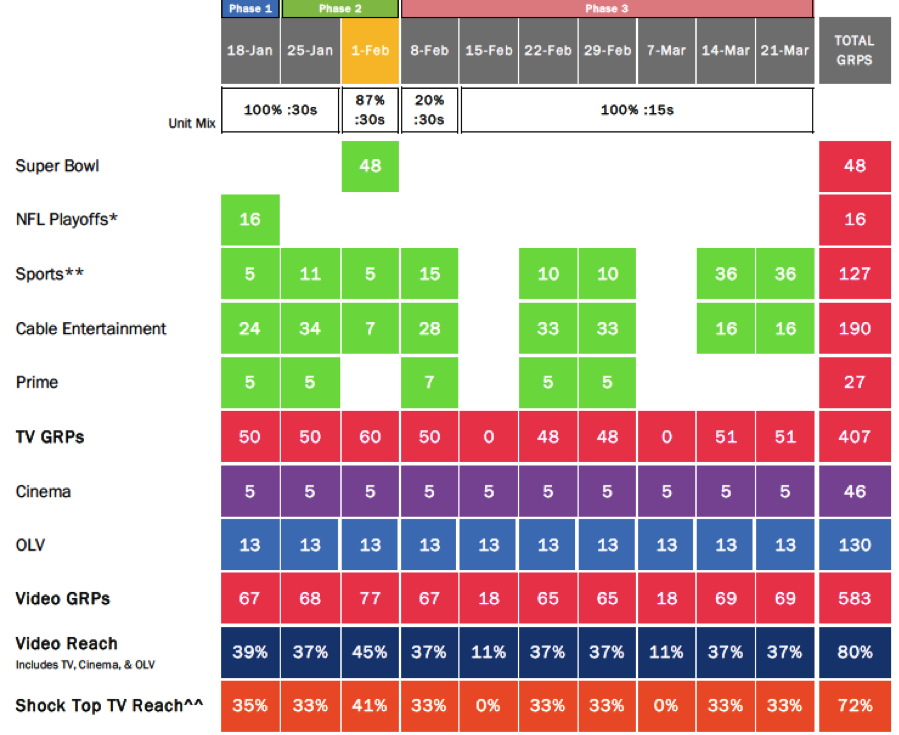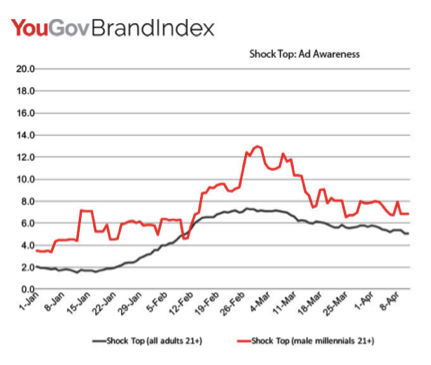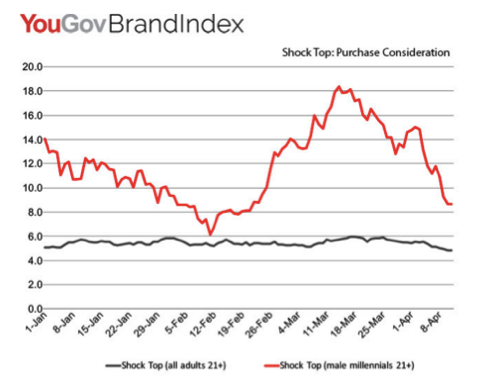Shock Top – Unfiltered Talk
Brand Content (SILVER)
Canadian Success on the Global Stage (SILVER)
Client Credits: AB InBev
Felipe Szpigel, VP High End
Jake Kirsch, VP Shock Top
Matt Alldian, Brand Manager
Mike Stewart, Manger of Broadcast Production
Agency Credits: Anomaly
Franke Rodriguez, Partner
Dave Douglass, Executive Creative Director
Pete Breton, Executive Creative Director
Brendan Scullion, Writer
Martin Montana, Writer
T.J. Miller, Writer
M.Miller Davis, Writer
Neil Blewett, Writer
Leanne McLellan, Head of Broadcast Production
Nicole Poon, Senior Broadcast Producer
Natalia Winardi, Producer
Paul Lipson, Director of Communications Strategy
Dion Aralihalli, Executive Business Director
Ali Cornford, Account Director
Kristin Meier, Account Supervisor
Colin Kikcio, Account Executive
Rob Murray, Producer
7thFl, Production Studio
Oleg Portnoy, Art Direction
Kevin Filliter, Art Direction
Production: Anonymous Content
Editorial: School Editing
Post Production: Fort York VFX
Post Production/Colour: Alter Ego
Section I — CASE PARAMETERS
| Business Results Period (Consecutive Months): | January- February 2016 |
| Start of Advertising/Communication Effort: | January 2016 |
| Base Period as a Benchmark: | Calendar 2015 |
| Geographic Area: | USA (national campaign) + Canada (online only) |
| Budget for this effort: | Over $5 million |
Section IA — CASE OVERVIEW
Why should this case win in the category (ies) you have entered?
This case demonstrates the ability of a successful Canadian idea that was adapted to save the Shock Top brand from a massive challenge south of the border. In the incredibly crowded and challenging craft beer category, Shock Top U.S. was in decline for the first time in the brand’s history, facing 12 straight months of negative sales.
The power of this case was in the idea – Give the beer a voice – which was as strong as the flavour of Shock Top and as unfiltered as their brewing process. So while other beer brands prattled on about their ingredients and flavour messaging, we simply let our beer speak for itself – literally.
We used our Shock Top Wedgehead logo as our unfiltered spokesperson and instantly had an entire nation loving Shock Top, with our product in the spotlight. And it worked. In just three short months, the campaign earned over one billion impressions and achieved record sales that continued months after the campaign ended. This was a unique campaign, with incredible insight and results, that kept the product integral to the story. It’s a perfect demonstration of a Canadian success story on the global stage.
Section II — THE CLIENT’s BUSINESS ISSUES/OPPORTUNITIES
a) Describe the Client’s business, competition and relevant history:
Craft beer is currently the second-largest driver of beer growth in the United States. The category is continuing to flourish year over year and was up 11% in sales vs the previous year in 2015. This growth is dominated primarily by the proliferation of items (resulting in reduced velocity per item) that create a very crowded and competitive landscape and a sea of sameness in the consumer’s mind.
While the segment was continuing to grow because of consumers’ desire for discovery and choice, it became apparent that what was driving the greatest growth was flavour. Shock Top, a Belgian-style wheat beer, had found a way to differentiate itself because of its unique flavour profile and had seen strong success with minimal support since launch in 2007. The growth was also fuelled by the irreverent attitude of the brand, represented in a series of disruptive tactics that made the brand stand out in contrast to its largest competitor Blue Moon (which was seen as the low-key, artfully crafted “dad beer”).
Shock Top was poised to continue to build on its existing momentum; however, the growth of the brand began to stagnate and, in 2015, Shock Top was suddenly in consecutive months of decline for the first time in its history. It had lost focus in-market and a lack of clear direction and scattered messaging had resulted in lost affinity and softened results for the brand.
Heading into 2016, Shock Top was at a pivotal moment as it faced a “make or break” first quarter – the brand had to reverse the business decline in two short months or risk losing any marketing support in the future.
b) Describe the Client’s Business Issues/Opportunities to be addressed by the campaign:
Heading into 2016, Shock Top had lost focus with its communication and marketing efforts. The brand had moved away from what had originally separated it from other beers: the fun, irreverent personality that connected it with their target. It also lacked a single-minded idea and clear positioning to guide growth, and communications in the marketplace was scattered.
Given the clutter of the craft beer segment and with only four out of ten consumers knowing what Shock Top was, it was going to take something pretty unique that beer drinkers hadn’t seen before if the brand was going to be considered.
Faced with this challenge, and without an agency of record, the brand looked to the success of Shock Top in the Canadian market, where our unique 360º campaign had propelled the brand from an unknown beer at launch (with 7% awareness) to become the #1 wheat beer in Canada (and fastest-growing high-end beer) in its first two years in-market. And even though the American marketing community generally refers to Canada as a “test market” because of our smaller size and scale, the results of the work in Canada were undeniable and couldn’t be ignored. As such, we were tapped to bring the magic of our Canadian campaign south of the border.
Our opportunity: Could we reinvigorate an ailing brand by getting Shock Top into the hearts and hands of all Americans, driving unprecedented growth in two short months?
c) Resulting Business Objectives: Include how these will be measured:
Make Shock Top famous.
The biggest problem Shock Top had to overcome was that 60% of Americans had never heard of the brand. Given the growth of the category and Shock Top’s decline in 2015, we had aggressive objectives to meet within a two-month period:
Core business objectives:
1.Increase awareness with 21- to 34-year-old men in Q1 2016
2.Increase weekly consumption for P3M in Q1 2016
In order to further drive brand affinity and awareness, we set two main communication objectives:
Core communication objectives:
1.Generate 300 million earned impressions nationwide
2.Garner 1 million YouTube views of our content
Section III — YOUR STRATEGIC THINKING
a) What new learnings/insights did you uncover?
As we analyzed the craft beer category, it became apparent that the majority of beer brands fall into one of two categories:
- Big brands that were taking themselves too seriously by focusing their messaging on their brewing process, talking about their flavour profile, etc.
- Small craft brands that were using their quirky names and packaging to stand out
Yet between these, a unique white space existed for Shock Top, a beer with a big personality, colourful character and great flavour.
Our target was looking to expand their repertoire of beer for a different experience. They like experimenting but were intimidated by the complexity of craft beer. Our strategy was to position Shock Top as an approachable brand. As Shock Top is a confident, unfiltered, flavourful beer, we didn’t need to ramble on and sell beer drinkers on ingredients, niche styles or stories about our brewers. We chose to lean in to talking with our consumer versus leaning on pushing product-centric messages alone.
We let the flavour speak for itself.
b) What was your Big Idea?
Give the beer a voice that is as strong as the flavour of Shock Top and as unfiltered as our brewing process.
Our idea centred on bringing the brand to life via Wedgehead, Shock Top’s logo (an orange wedge with sunglasses and a mohawk haircut), our own straight-talking brand ambassador.
c) How did your Communication strategy evolve?
In order to stand out, we needed to leverage the personality that was an inherent part of the Shock Top brand (which was also key to the success that we saw in the Canadian market). Our logo (an orange wedge with a mohawk haircut and sunglasses, aptly named Wedgehead) was at the centre of our communication strategy. We needed to give Shock Top a voice to stand out from other brands and interact with consumers in a fun, unique way that would truly resonate.
Our communication strategy therefore focused on bringing Wedgehead’s personality to life with the aim of making him famous, and we set out to accomplish this across three main connection pillars:
1. Introduce Wedgehead to the world – stunt-based marketing and contextually relevant messaging in mass media channels
2. Make Wedgehead a YouTube star – long-form YouTube content to drive engagement and storytelling
3. Give Wedgehead a spot on the world’s biggest stage – a 30-second Super Bowl commercial and an unfiltered review of the Super Bowl ads to maximize our reach and impact
d) How did you anticipate the communication would achieve the Business Objectives?
Our target audience was legal drinking age to 34-year-olds who were looking for a taste upgrade from what the standard core beers offered – a beer that is flavourful while still providing refreshment. While their knowledge of beer is limited, they’re open to trying new things and experimenting, and are in a discovery state of mind. They don’t have a mindset to go out and party but to experience new things; this includes expanding their repertoire of beers. They drink mainstream beers like Budweiser and Coors Light as well as a variety of domestic specialty beers.
Ask most beer lovers if they have good beer judgement and the answer will invariably be yes (whether true or not). Fact is, our target group knew they could discern good beer from bad beer the second they tasted it. So rather than do what our competitors were doing – hard selling consumers with a laundry list of product RTBs and ingredients – Shock Top set out to provoke beer lovers into trying the brand in a provocative way: by appealing to our target’s inner sense of good judgment and confidently taking the position that the only thing that matters when it comes to beer is the flavour. We wanted to have fun, unfiltered conversations that would resonate with our target; these would help us break through the clutter to drive awareness of Shock Top, ultimately resulting in trial of the brand and reversing the decline in sales.
Section IV — THE WORK
a) How, where and when did you execute it?
Our communication strategy centred on bringing Wedgehead (Shock Top’s logo) to life and giving him an actual voice. We selected channels where Wedgehead’s personality would shine and allow him to speak directly to our consumers.
AMBIENT/STUNT BASED MEDIA: We introduced Wedgehead to America in January with a hyper-targeted multimedia campaign to get Shock Top on the shopping list. We essentially planted Wedgehead in various ambient places where he could strike up conversations with beer lovers. We created talking packaging and placed it in the aisle of a grocery store, with the stunt documented and repurposed as video on YouTube and our social media channels. We also had him come to life in a big way with a giant billboard on Venice Beach.
PRINT, OOH AND DIGITAL BANNERS: We brought Wedgehead to life via a series of contextually relevant print ads, OOH ads and geo-targeted digital banners that brought to life the brand personality in a unique way based on the media placement.
SUPER BOWL TV: In order to guarantee national exposure and awareness, the brand made an unprecedented move and purchased a 30-second commercial in Super Bowl 50. There was a lot on the line – it was a huge feat to be the first beer brand outside of core to advertise in AB InBev’s history. We partnered with notoriously unfiltered personality T.J. Miller (star of the hit TV show Silicon Valley) and let Wedgehead and T.J. have a totally unfiltered and unscripted conversation.
ONLINE CONTENT: We released the long-form version of our Super Bowl spot the week prior to the game, driving incremental impressions and ensuring the brand was part of the buzz leading up to game day. We also created 16 pieces of unique content from our Super Bowl spot that were posted online in the lead up for consumers who wanted to dive deeper into our story. The morning after Super Bowl 50, we posted a five-minute film with Wedgehead and T.J. hilariously reviewing the Super Bowl commercials. Wedgehead and T.J. reviewed, entirely ad lib, some of the most notorious ads from the game: Budweiser’s “Not Backing Down,” Heinz’s “Weiner Stampede,” Hyundai’s “Ryanville,” Mountain Dew’s “PuppyMonkeyBaby” and even our own ad from the game. The film was shot and edited in less than 24 hours to ensure it was posted online in a timely manner to capitalize on the conversation.
CINEMA: The long-form version our Super Bowl spot ran in cinema nationwide prior to comedy movies to drive home the fun, irreverent personality of our brand.
PR: Surrounding the Super Bowl, we had a national PR blitz that resulted in coverage of the campaign in 889 placements, engaging millennial consumers online, driving buzz with mainstream media, garnering credibility with business press, and driving additional social media shares.
c) Media Plan Summary

Section V — THE RESULTS
a) How did the work impact attitudes and behaviour?
As soon as our campaign launched in-market, we saw immediate engagement, traction and, most importantly, impressive results.
Core communication objectives:
1. OBJECTIVE: Generate 300 million earned impressions nationwide
EXCEEDED: We generated over One billion PR impressions nationally
2. OBJECTIVE: Garner 1 million YouTube views of our content
EXCEEDED: Over the campaign period, we achieved over 14 million views of our YouTube content
In addition, consideration for the brand increased to 16.9 (+2ppt vs. Dec.) an all-time high.
b) What Business Results did the work achieve for the client?
With Q1 2016 being the “make or break” quarter for Shock Top, there was an immense amount of pressure on the brand to deliver strong results. While we knew we had proven success in the Canadian market, we never could have anticipated the impact achieved, especially in a market as diverse and difficult as the United States.
Shock Top overachieved its objectives and grew significantly on virtually all business metrics, resulting in an all-time high of awareness for the brand.
- Awareness: increase to 48.6 (+7.4ppt vs. Dec.) an all-time high
- Consumption: increase of P3M (Past 3 Month Consumption) to 11.8% (+1 vs. Dec.)
- Sales: increase from -16% at the end of January to +15% in March (-3% YTD)
Most importantly, we established a breakthrough brand campaign that had all of America talking about Shock Top, giving a once silent brand, a strong, ownable voice.
c) Other Pertinent Results
N/A
d) What was the campaign’s Return on Investment?
N/A
Section VI — Proof of Campaign Effectiveness
a) Illustrate the direct cause and effect between the campaign and the results
While there are variables, such as regional pricing, that can affect sales results in the beer category, we are confident in saying that there was a strong relationship between activity and results.
Shock Top experienced a record quarter, with an all-time high for awareness and consideration, when there was no other major marketing activity beyond our campaign. The program received one billion PR impressions, bringing to life Shock Top’s unique spokesperson Wedgehead by engaging with consumers across the United States and beyond.
And while we knew that we had a powerful campaign on our hands (as indicated by the record results achieved during creative testing), the most powerful indication was an article in Forbes magazine two months post-campaign with the title “Shock Top Wedgehead Still Delivering.”
“Since the campaign first launched, Shock Top has maintained elevated ad awareness among adults (21+) well beyond their initial Super Bowl lift. The ad is resonating with millennial men (21–34), peaking with ad awareness of 13% on March 1st.”

“Purchase consideration, a strong indicator of future sales, was most impacted for millennials 21+. Measured at around 7.5% around the Super Bowl, consideration rose to 18% with younger men in mid-March and has more recently settled down to 9%.”

b) Prove the results were not driven by other factors
Campaign spend vs. history and competition:
Spend was consistent with other brands advertising during the Super Bowl time period, with our campaign resonating incredibly well with sales continuing to carry in the absence of media weight into March and April (as referenced in Forbes in the previous section).
Pre-existing Brand momentum:
With Shock Top being in decline for the first time in the brand’s history, we had no momentum to build from, but rather it was a truly uphill battle.
Pricing:
There were no pricing initiatives during the program.
Changes in Distribution/Availability:
There were no distribution changes for Shock Top.
Unusual Promotional Activity:
There were no other major marketing activities while our campaign was in-market.
Any other factors:
N/A